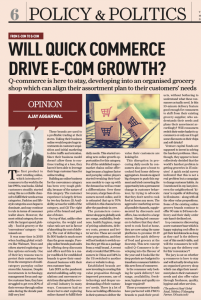Sometime in the midnineteenth century, following its civil war, America went through severe recession as gold, silver and currencies had been hoarded, creating shortages of currency in the market. Grocery retail chains started minting their own copper, brass and tin coins to give their customers as change in return. Customers then had to come back to the same store to redeem those coins for their next purchase. These retailers soon realized the benefit, with customers coming back for repeat purchases without any marketing effort. They had inadvertently created a kind of closed-loop loyalty program.
When governments of some states issued prohibition o n su ch coins, retailers found innovative ways of call- ing their customers back. Cutting out a brand trademark from packages of their purchases could be redeemed at the next purchase. And every product trademark cutout was valued differently for redemption! The value of these cutouts was around 1.25% of the value of the product sold earlier, so it appears that retailers were marketing these as profit-sharing programs, taking inspiration from dividend payments to shareholders. Some brands created a redemption catalogue based on the number of trademark coupons redeemed – such as boxes of crayons, Uncle Sam’s suspenders or ladies’ handbags for 25 to 200 trademark cuttings.
The trend grew and more marketing genius pitched in. By the early twentieth century, retailers started releasing sets of stamped coupons against every purchase. Based on the value of each purchase, customers were issued sets of stamped and signed coupons which could be redeemed at any store of the chain against the next purchase. This model matured into coupon catalogues, which were sold by consumer marketing companies for various brands. With a brief dip during the Second World War, it is estimated that this business grew until more than US$750 million worth of coupons were sold in the USA. It is believed that over 83% of the families in the US were using coupons for their grocery purchase! Very soon these coupon companies started broadening the scope of their redemptions across airlines, hotels and banks as well. And this is when modern coalition loyalty programs were born. Looking back over the last century-and-a-half, it is fascinating to observe that the core design of the loyalty programs remained the same.
The currencies have changed, but across trademarks, stamps, coupons, miles or points, the program design hasn’t changed. All brands use the same approach of issuing tokenized currency to their customers based on their spend value and allow them to redeem as pets their choice. Modes of communication have changed from physical coupons to mailers, and now to direct phone messages to consumers. Brands have not created any model of value-based engagement with their customers to bring them closer to their brand to build long-lasting relationships. Modern brands have not drawn any difference between reward programs and loyalty programs. Most now run reward programs, and expect loyalty from their customers. Many global brands clearly focus on rewards as their key value proposition, and clearly focus on calling their customers back to redeem rewards. Some of them have branded their rewards in local cur- rency rather than points or miles so that customers can see real value in their wallets. Every retail brand collects customer transaction data to populate their CRM systems, and this gives them a huge opportunity for meaningful interactions based on the insights from this data. Instead, what we see are meaningless promotional messages, and these are unlikely to have much outcome.
Brands need to become loyal to their customers rather than expecting loyalty from them towards the brand! After the pandemic, brands are looking for ways to engage with their consumers with a purpose. Most of these brands are sitting on huge volumes of data about their customers. Since they are now also engaging with these customers on online channels and social media, the effort should be to integrate data across these channels and create a single view across the brand. Modern data-science tools driven by AI-ML models can help give deeper insights on the value of the relationship, the recency and frequency of commerce, buying preferences, likes and dislikes, and many other traits of commerce to create useful engagement strategies. In the absence of such insights, brands will only engage in meaningless mass marketing with the entire customer base which is likely to have a very poor response or even a negative response.
Most brands have introduced mobile apps and are now encouraging their customers to use these apps for various needs, though most are still limited to commerce and have not yet gone beyond that. Instead, this could be used as a really great platform to create personalized engagement with personalized offers based on buying history and trends rather than just pushing mass offers as they now do. Some in-store brands have started exploring self checkouts using these apps with built-in personalized pricing based on basket history and customer value. Mobile apps are also a great way to build subscription models for food and convenience brands to create loyalty. Some coalition reward programs across various sectors including hospitality, travel, airlines and banks, are most suited for creating personalization since they service a much larger member base across multiple partner brands. Instead of just pushing offers and merchandise at discounted prices they have an opportunity to offer data-led content and experience-led commerce across the partner brands.
There have been some experiments by offering crypto-based tokenized assets, carbon credits and bits of stocks (partner company shares). However due to regulation issues these initiatives have not been fully commercialized. Looking at Metaverse and Web 3 technologies in future, many more exciting blueprints are being drawn up to offer next-generation loyalty models. More about these another time!
This article first appeared in The Business Guardian on 25 August 2022.




